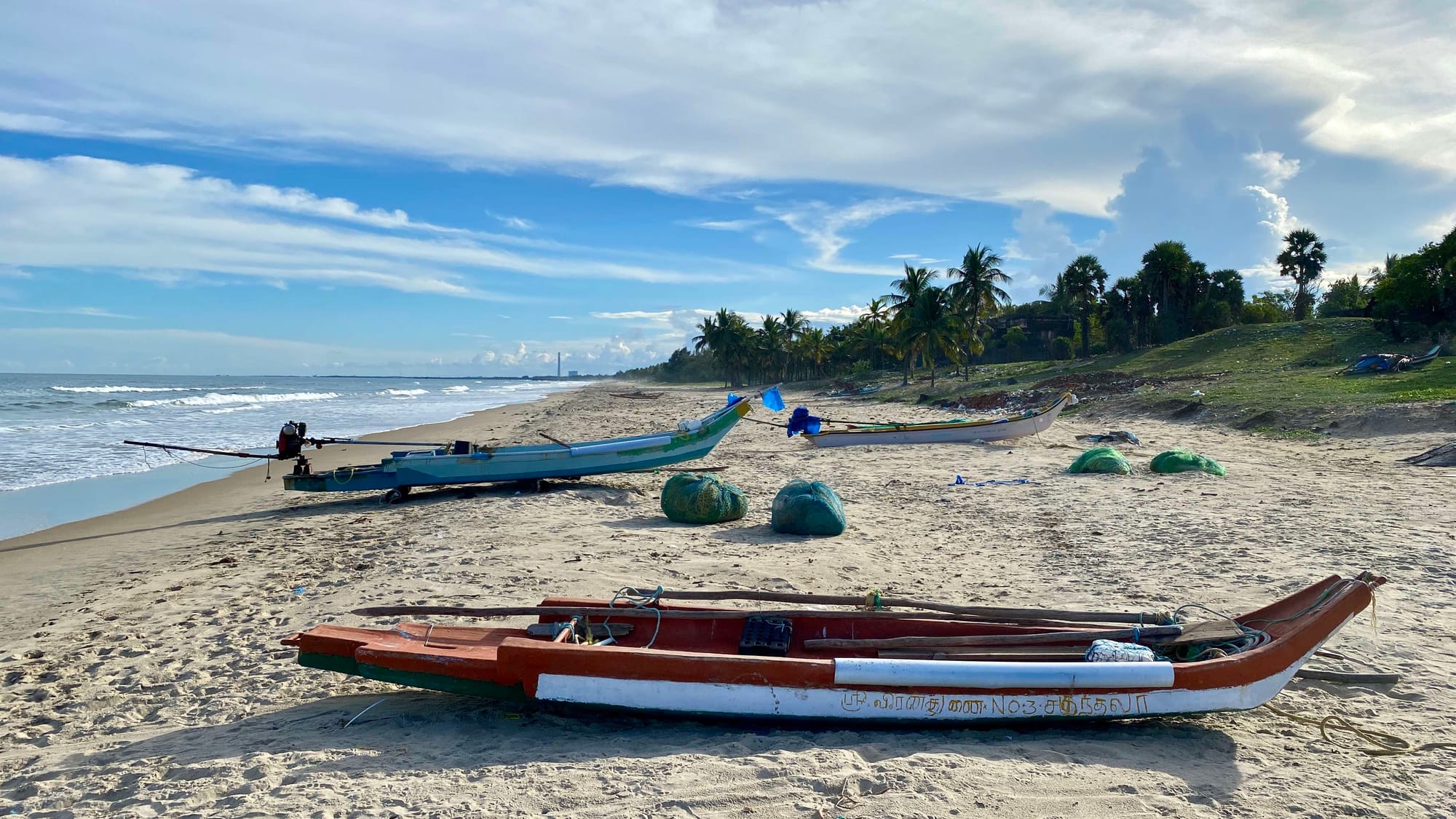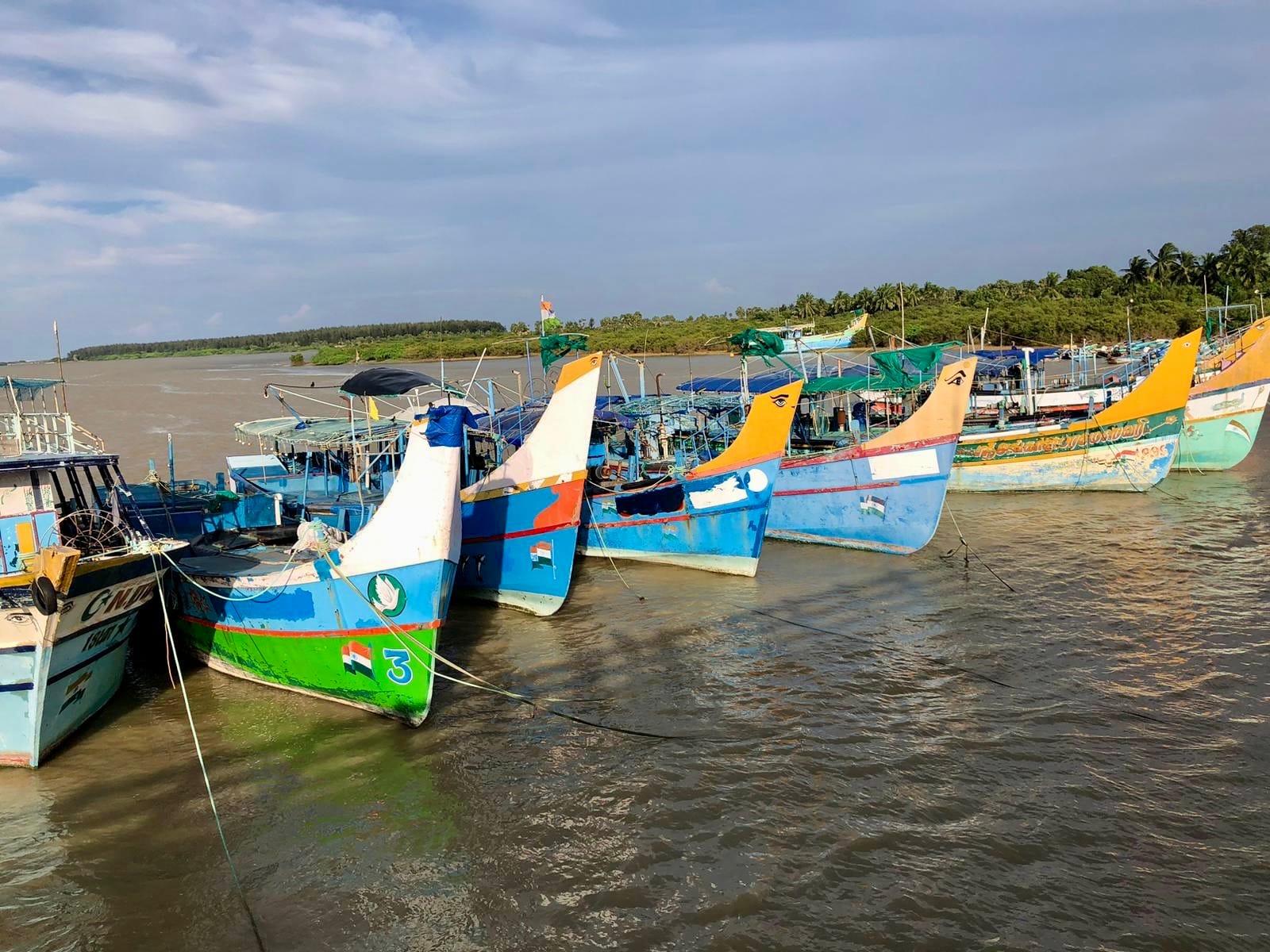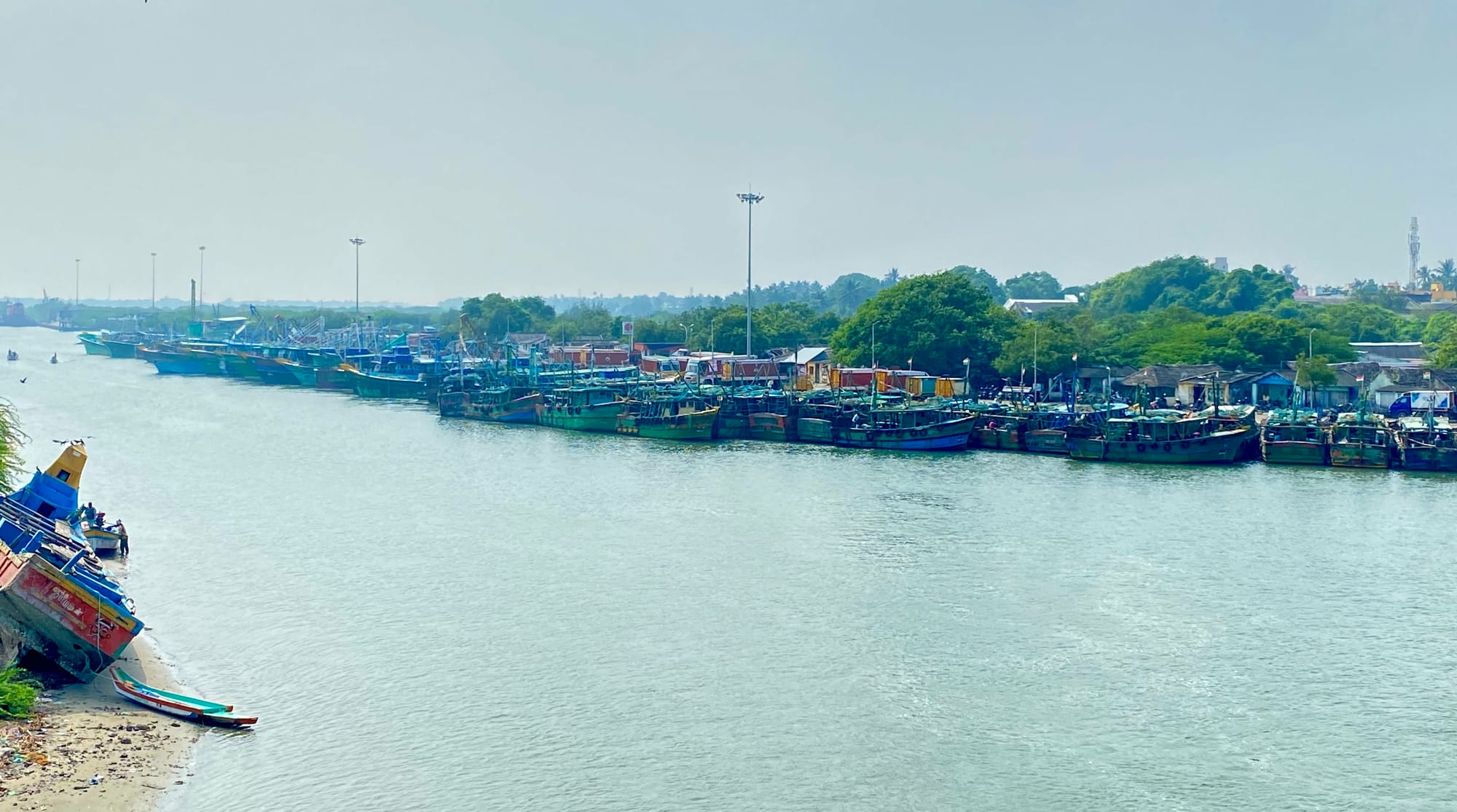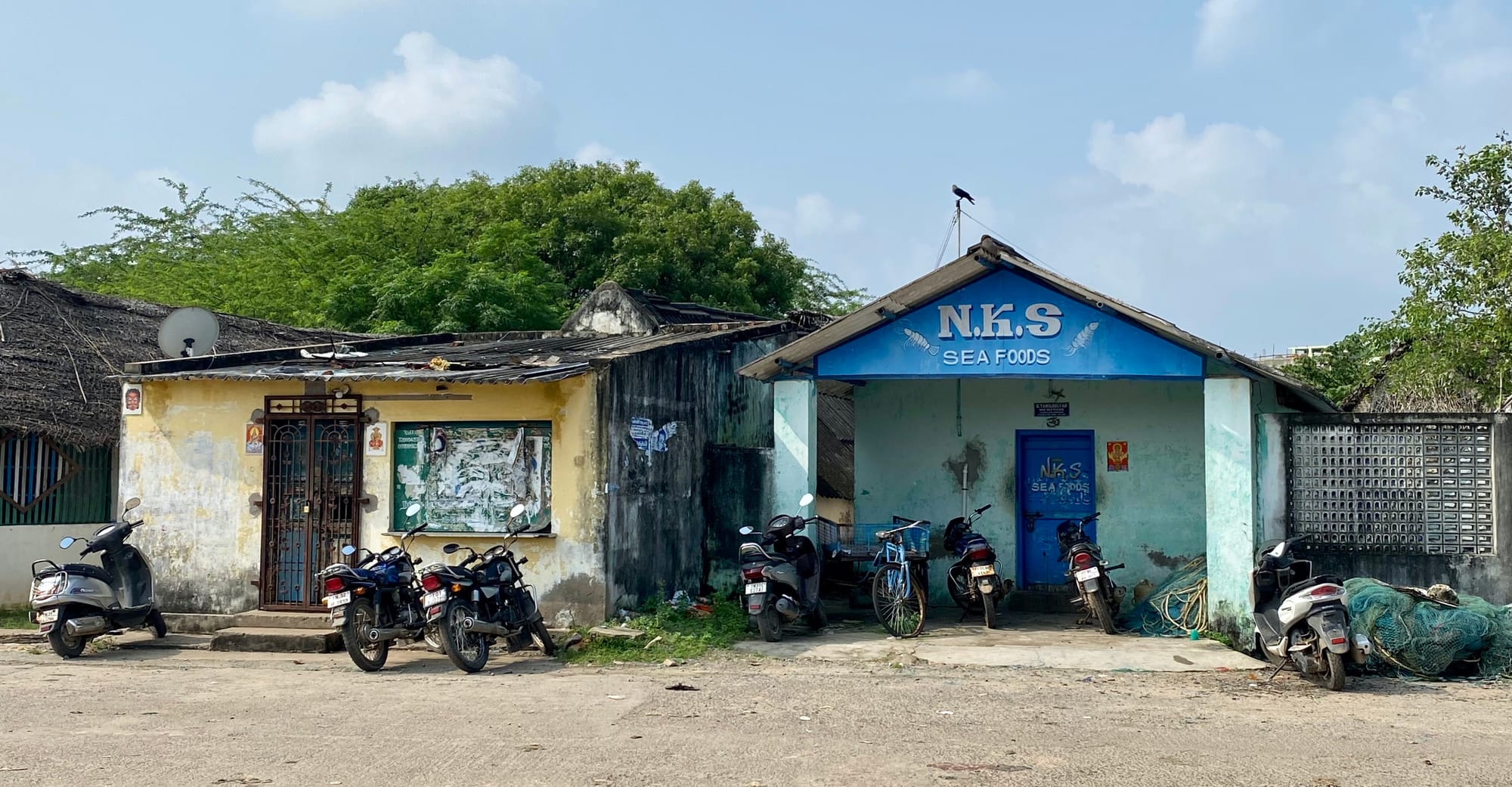#10 The rise and fall of Cuddalore’s ring-seiners

By Jan Mogens Borchert
This month, we bring to you a series on how the modernisation of harbours in India is changing the lives of fishers in relation to the politics of their livelihood, and overall well-being. This story, written by guest author Jan Mogens Borchert, a social science researcher at the University of Amsterdam, traces the transformation of fishers' lives in Cuddalore harbour in Tamil Nadu in the aftermath of the devastating tsunami of 2004, a large number of whom took up ring-seine fishing. The story reflects on the deep inequalities that exist within the members of the fishing communities based on the different techniques of fishing they adopt. This is Part 1.
Fishing is an age-old occupation on the Coromandel Coast of Tamil Nadu, but one that has changed dramatically over the past generation. With India’s economic liberalisation and industrial development, the fishing sector has been transformed over the last twenty years, affecting the livelihoods and welfare of Tamil Nadu’s nearly one million fishermen in many ways.
In the rapidly urbanising area around the town of Cuddalore, the fishermen’s livelihoods have been changed by a number of factors, including technological development, economic transformation, a natural disaster, and intra-communal conflict. During three months of fieldwork in October through December of 2023, I traced how these changes have unfolded and how new infrastructure developments around Cuddalore’s fishing harbour may play a role in shaping the future of its fishermen.
“When I started fishing, we used to go out with paddles. We used mada valai (cotton dip nets) or landing nets and went out on the kattumaram,” recalls an elderly fisherman from his youth, referring to the small boats constructed by tying together several wooden logs. The Indo-Norwegian project (1952-72) had aimed to modernise coastal fisheries in several ways with a pilot project in Kerala, and the Indian government introduced the first mechanised fishing boats with heavy subsidies, making them affordable to (at least some) local elites. It is unclear in which year the first mechanised trawlers arrived, but the All India Marine Fisheries Census of 1980 counted 299 trawlers in South Arcot district (comprising the present-day districts of Villupuram and Cuddalore). A growing number of trawlers began to use the port in Cuddalore’s Old Town section, which they shared with cargo ships exporting commodities mined in the hinterland of Cuddalore, such as iron ore and coal. According to the All India Marine Fisheries Census, the proportion of mechanised boats increased from 8.38% in 1983 to 19.66% in 2005. However, the majority of Cuddalore’s fishermen continued to fish in an artisanal manner until the turn of the millennium, when outboard motors and fibreglass boats became popular.

Then everything changed in a single day. The Indian Ocean tsunami, which originated west of the Indonesian island of Sumatra, struck the Coromandel coast on 26 December 2004, killing 537 people in the Cuddalore district and destroying settlements and boats. The cargo port in Cuddalore Old Town was destroyed by the wave, resulting in the cessation of export activities. In the wake of the disaster, the Indian government and a multitude of intergovernmental and non-profit organisations rushed to provide aid and investment to the region.
In addition to rebuilding homes for displaced fishing families and as well as schools and community centres, this also meant a huge influx of new boats. “Before the tsunami, maybe five people in our village had a boat. But suddenly everyone got a new fibre boat,” states a fisherman from a smaller village. Some organisations distributed boats directly, while others, such as WorldVision, provided loans that groups of fishermen used to buy the first steel-body trawlers in Cuddalore. Furthermore, the Marine Products Exports Development Authority (MPEDA) conducted training on behalf of the Indian government on new, larger nets that could be used to catch larger fish for export. The same man recalls: “But most of the fishermen were not interested in this.”
The era of the ring-seine
They soon became interested in another technique. Purse-seine nets had been introduced in the western state of Kerala in the 1960s as part of the Indo-Norwegian Project and had made their way to Tamil Nadu by the 1990s. They are operated from a larger vessel and form a circle with floating elements. The net is then closed at the bottom and pulled out of the water at the top. This encirclement allows for large quantities of fish to be caught, potentially whole schools including juveniles, leading to concerns about overfishing.
These concerns led to the issuance of Government Order 40 (GO 40) by the Department of Animal Husbandry and Fisheries in the year 2000, which banned the use of purse-seine nets of any size by any type of boat along the entire Tamil Nadu coast and within the state’s territorial waters, i.e. up until a distance of 12 nautical miles (22.22 kilometres) from the coastline. The stated purpose of this order was to conserve fish stocks. However, it only remained in the law gazette and was not enforced anywhere in Tamil Nadu for almost two decades.
After the tsunami, many fishermen from Cuddalore temporarily migrated to Kerala, on the unaffected west coast of India, where they were introduced to purse-seine fishing. Working as labourers in these well-established operations changed their minds about purse-seining and they saw the potential for an alternative way of fishing on their own shores. “We worked in Kerala and liked the way they fished there, so we bought the nets and brought them here,” recalls an elderly fisherman.
The first ring-seine nets, a smaller version of the purse-seine nets, could be operated with the fibre boats that had been distributed after the tsunami and the catches were landed on the beach. The cost of these nets was high, so 25 to 30 fishermen pooled their money to buy and operate the net together. They went out every day and shared the profits. The adoption of these nets picked up fast, with the Marine Fisheries Census of 2005 already counting 42 ring-seine operations in Cuddalore district.
The next step in the development of ring-seining was the introduction of purpose-built ring-seining vessels, the kanaa boats in 2006. These 15 - 20 metre long boats with a sharp bow and powerful engines required considerable investment, costing between 42 lakh and one crore Indian rupees (INR) (50,759 – 120,856 US dollar). One fisherman who joined fishing at that time recalls his euphoria: “I was crazy about getting in on this. After I found out the cost of the boat, I gathered other people. I brought our jewellery to the bank for a loan and most other people also took debt for their share. Then, the most talented of our group went to Kerala to buy the boat.”
Initially each shareholder invested the same amount, but over time the number of shareholders per boat decreased as shareholders who had become wealthier through gains from ring-seining bought out other shareholders. Eventually, many shareholder groups consisted of only 5 to 10 shareholders, each holding several shares. The kanaa boats were accompanied by four or five fibre boats that helped spread the net and carried some of the catch. Each fibre boat received two shares in the operation. The third stage of professionalization saw the introduction of purpose-built steel body vessels costing up to INR 1.2 crore (USD 143,624). These went on multi-day trips with longer distances and abandoned crew profit-sharing, with workers only receiving a fixed wage. It is important to note that all three forms of ring-seine fishing coexisted and at times came into conflict with each other.

The increased incomes from ring-seine operations allowed many small-scale fishermen to significantly improve their standard of living. “[During] that time we ate well and it was easy to send my children to a good school”, recalls one fisherman. He adds, “We bought jewellery and gave out loans to others to make money”. While small-scale fishing was a year-round affair, ring-seine fishing mostly took place from January to March or April. “We worked hard these three months, saved our money and spent it the rest of the year.” A fisherman in his 30s remembers that “during the ring-seine, our parents never had to work.” Furthermore, the improved social status led to the spread of another phenomenon associated with aspiring to or even achieving middle class status in India: “housewifisation”, the trend whereby as household incomes increase, female household members stop participating in the labour force and concentrate solely on domestic work.
Since the kanaa boats were too large to operate from beaches, they had to use harbours. When the Cuddalore Port was damaged by the 2004 tsunami and cargo exports stopped, the trawlers had moved to the less damaged part of the port north of the confluence of the Gadillam and Upannar rivers, which was henceforth called Cuddalore Fishing Harbour. This harbour is made up of a 900 metre-long concrete pier on the western bank of the Gadillam river, which ends in a creek formed by a now dormant tributary. Across the creek and adjacent to the road entrance to the harbour is a dry dock for the construction and maintenance of trawlers and fibre boats.

The fishing harbour’s land is managed by the Port Authority of Tamil Nadu and leased by the State Fisheries Department. This is in contrast to the land of most other fishing harbours, which is directly managed by the Fisheries Department. Old redundant facilities such as freight tracks were demolished. To better suit the needs of fishing operations, two rudimentary net-mending halls, two fuel stations, washrooms, and electric light poles were built and installed. As fish traders and ring-seine operators became more affluent, they leased small plots of land in the harbour and constructed single-storey buildings to store fish, nets and other equipment, and to house their small offices.

The Clash
The number of kanaa boats kept increasing until 2018. Ring-seine boats were not registered, making precise reporting of their number difficult. The Marine Fisheries Census 2016 attributes 134 boats to three villages that use the Cuddalore Fishing Harbour (CMFRI & DoF, 2020), while Bavinck (2020) reports an estimate of around 150 kanaa boats using the harbour along with their accompanying fibre boats in 2016. There was little contact between trawler owners and ring-seine operators, because the trawlers usually returned to the harbour in the early hours of the morning between 3 and 7 am, while the kanaa boats did not return from the sea until midday, and the different boat types were parked in different parts of the harbour and the river. They also fished in different areas. Mechanised trawlers generally venture out further than 10 nautical miles (18.52 kilometres), while ring-seine operations usually stayed in the inshore zone, which was also frequented by small-scale fishermen.
This led to conflict with those small-scale fishers who continued fishing with smaller, passive nets. While many small-scale fishermen had seen their catches decline due to the competition from the ring-seines and eventually had given up and joined ring-seine operations as labourers, not everybody was willing or able to make that switch. The opposition to ring-seining came mainly from smaller villages in the more rural coastal stretch south of Cuddalore, led by the village of Samiyarpettai. However, there were also people in the larger villages close to Cuddalore fishing harbour who continued small-scale fishing and resisted ring-seining.
This active opposition, combined with the tensions between competing ring-seine operations, led to an increasing number of verbal conflicts, which eventually resulted in a violent clash in May 2018. As with mechanised trawlers, ring-seine operations usually abided by the prohibition of fishing during the ban period between April and June. This annual fishing ban serves to give fish stocks time to regenerate, but does not extend to small-scale fishing with fibre boats or wooden kattumarams. In this particular instance, a group of fishermen from Sonankuppam village, which was heavily involved in ring-seining, set out to fish in near-shore waters with a suttu valai, a surrounding net that could be considered a small version of the ring-seine. Ring-seiners from Devanampattinam, the head village of the area and heaviest ring-seine users, were outraged by what they perceived as a transgression of the fishing ban. The conflict around this incident escalated when a large group from Devanampattinam attacked Sonankuppam fishermen on their own turf. A fisherman from Sonankuppam recalls: “They came here to fight, carrying big knives, spears, steel rods and other tools. It escalated in front of the temple, where they threw stones at our people and the temple building.” In the ensuing brawl, K. Panchanathan, a fishing leader and AIADMK party member, was killed by stabbing.
The incident galvanised support for the opposition to ring-seine nets. Several cases were filed seeking enforcement of GO40, the Fisheries Department regulation that had legally banned the use of ring-seine nets in Tamil Nadu in 2000 but never had been enforced. This changed in the spring of 2019, when the Fisheries Department started closing ring-seine operations and confiscating the nets of fishermen who ignored the newly enforced ban.
(End of Part 1)
Jan Mogens Borchert is a research master’s student in International Development Studies at the University of Amsterdam and holds a B.Sc. in Political Science from the Technical University of Munich. He is interested in the livelihood and wellbeing of rural and urban marginalized communities with a focus on South Asia and East Africa.
Sibinthar A was an indispensable part of this project, in which he served as a research assistant and interpreter. He holds an M.Sc. in Oceanology and Coastal Area Studies from Alagappa University, and is working as a project associate at MS Swaminathan Research Foundation
Note: The feature image, copyrighted to FERAL, was taken from a publication by Ajit Menon, Maarten Bavinck, Tara N. Lawrence, Nitya Rao, Muthusankar G., Balasubramanian D., Arunkumar A.S., Bhagath Singh A., Senthil Babu D., and Nicolas Bautès (2022) called Coastal Transformation and Fisher Wellbeing: Perspectives from Cuddalore District, Tamil Nadu, India. Madras Institute of Development Studies. Chennai.
